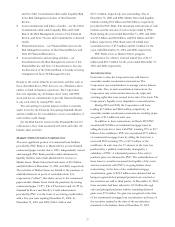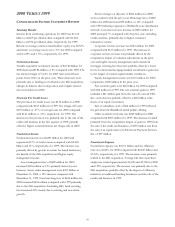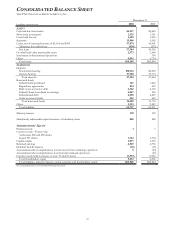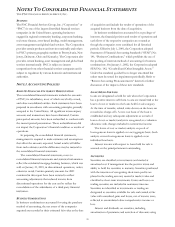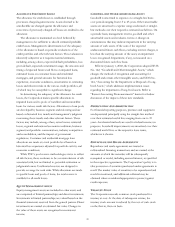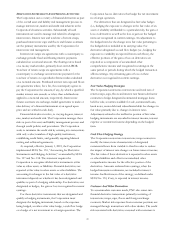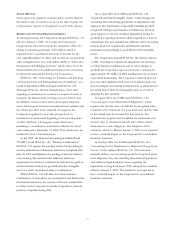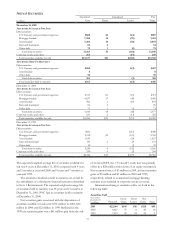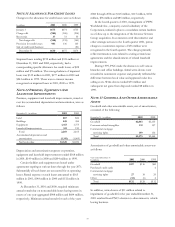PNC Bank 2001 Annual Report Download - page 69
Download and view the complete annual report
Please find page 69 of the 2001 PNC Bank annual report below. You can navigate through the pages in the report by either clicking on the pages listed below, or by using the keyword search tool below to find specific information within the annual report.67
the effective-interest method, are included in interest
income. Gains and losses realized on the sale of securities
available for sale are computed on a specific security basis
and included in noninterest income.
LOANS AND LEASES
Loans are stated at the principal amounts outstanding, net of
unearned income. Interest income with respect to loans
other than nonaccrual loans is accrued on the principal
amount outstanding. Significant loan fees are deferred and
accreted to interest income over the respective lives of the
loans.
The Corporation also provides financing for various
types of equipment, aircraft, energy and power systems and
rolling stock through a variety of lease arrangements. Direct
financing leases are carried at the aggregate of lease payments
plus estimated residual value of the leased property, less
unearned income. Lease financing income is recognized over
the term of the lease using methods that approximate the
level yield method. Gains or losses on the sale of leased
assets or valuation adjustments on lease residuals are
included in noninterest income.
LOAN SECURITIZATIONS AND RETAINED INTERESTS
The Corporation sells mortgage and other loans through
secondary market securitizations. In certain cases, the
Corporation will retain a portion of the securities issued,
interest-only strips, one or more subordinated tranches,
servicing rights and/or cash reserve accounts, all of which
are associated with the securitized asset. Any gain or loss
recognized on the sale of the loans depends on the allocation
between the loans sold and the retained interests, based on
their relative fair market values at the date of transfer. The
Corporation generally estimates fair value based on the
present value of future expected cash flows using
assumptions as to discount rates, prepayment speeds, credit
losses and servicing costs, if applicable.
Servicing rights are maintained at the lower of carrying
value or fair market value and are amortized in proportion to
estimated net servicing income. Retained interests in loan
securitizations are carried at fair market value and included in
other assets. For retained interests classified as securities
available for sale, adjustments to fair market value are
recognized through accumulated other comprehensive
income or loss. Fair market value adjustments for all other
retained interests are recorded in noninterest income. For
servicing rights retained, the Corporation generally receives a
fee for servicing the securitized loans.
For purposes of measuring impairment, the Corporation
stratifies the pools of assets underlying servicing rights by
product type and geographic region of the borrower. A
valuation allowance is recorded when the carrying amount of
specific asset strata exceeds its fair value.
NONPERFORMING ASSETS
Nonperforming assets include nonaccrual loans, troubled
debt restructurings, nonaccrual loans held for sale and
foreclosed assets. Generally, loans other than consumer are
classified as nonaccrual when it is determined that the
collection of interest or principal is doubtful or when a
default of interest or principal has existed for 90 days or
more, unless the loans are well secured and in the process of
collection. When interest accrual is discontinued, accrued but
uncollected interest credited to income in the current year is
reversed and unpaid interest accrued in the prior year, if any,
is charged against the allowance for credit losses. Consumer
loans are generally charged off when payments are past due
120 days.
A loan is categorized as a troubled debt restructuring in
the year of restructuring if a significant concession is granted
to the borrower due to deterioration in the financial
condition of the borrower.
Nonperforming loans are generally not returned to
performing status until the obligation is brought current and
has performed in accordance with the contractual terms for a
reasonable period of time and collection of the contractual
principal and interest is no longer doubtful.
Impaired loans consist of nonaccrual commercial and
commercial real estate loans and troubled debt
restructurings. Interest collected on these loans is recognized
on the cash basis or cost recovery method.
Loans held for sale, which are carried at lower of cost or
market value, are considered nonaccrual when it is
determined that the collection of interest or principal is
doubtful or when a default of interest or principal has existed
for 90 days or more, unless the loans are well secured and in
the process of collection. Nonaccrual loans held for sale are
reported as other nonperforming assets.
Foreclosed assets are comprised of property acquired
through a foreclosure proceeding or acceptance of a deed-in-
lieu of foreclosure. These assets are recorded on the date
acquired at the lower of the related loan balance or market
value of the collateral less estimated disposition costs. Market
values are estimated primarily based on appraisals.
Subsequently, foreclosed assets are valued at the lower of the
amount recorded at acquisition date or the current market
value less estimated disposition costs. Gains or losses
realized from disposition of such property are reflected in
noninterest expense.


